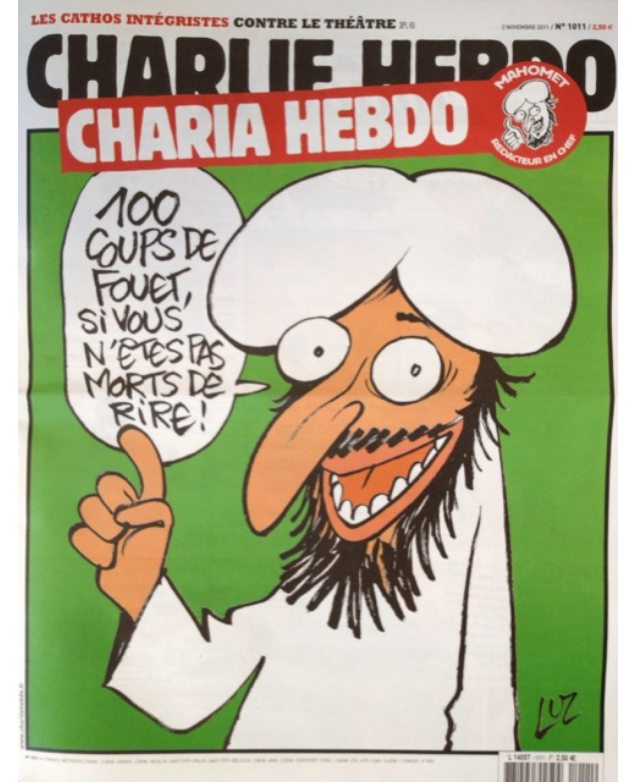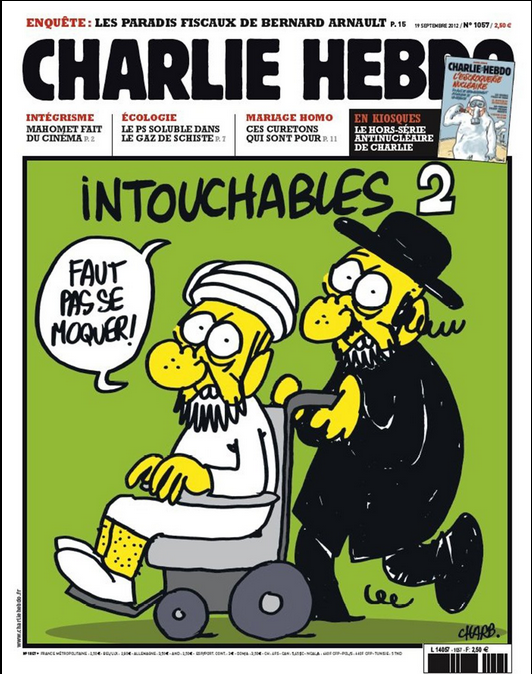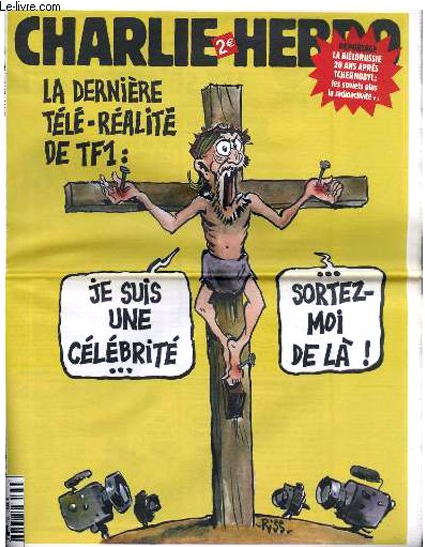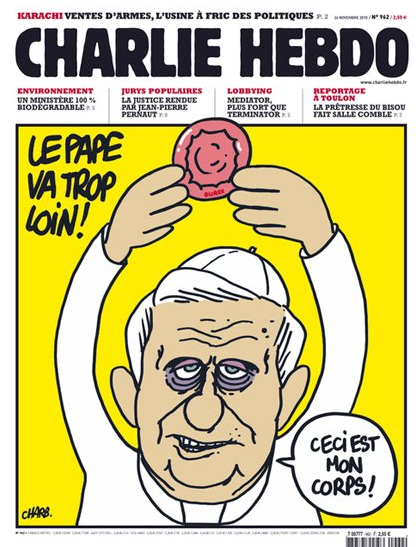WARNING : Content in this story maybe offensive or disturbing to some readers.
Charlie Hebdo, the French magazine where gunmen killed journalists and police in a brazen lunchtime attack Wednesday, is no stranger to controversy.
The Paris-based weekly satirical magazine, which was founded in 1970, became famous for its daring takedowns of politicians, public figures and religious symbols of all faiths.
And although the motive behind Wednesday’s massacre is not yet clear, Charlie Hebdo’s publishing of cartoons of the Prophet Mohammed in recent years has angered some Muslims and made it a target for attacks.
In November 2011 Charlie Hebdo’s office was burned down on the same day the magazine was due to release an issue with a cover that appeared to poke fun at Islamic law. The cover cartoon depicted a bearded and turbaned cartoon figure of the Prophet Mohammed with a bubble saying, “100 lashes if you’re not dying of laughter.”

In September 2012, as France was closing embassies in about 20 countries amid the global furor over the anti-Islam film “Innocence of Muslims,” the magazine published an issue featuring a cartoon that appeared to depict a naked Mohammed, along with a cover that appeared to depict Mohammed being pushed in a wheelchair by an Orthodox Jew.

Charlie Hebdo journalist Laurent Leger defended the magazine at the time, saying the cartoons were not intended to provoke anger or violence.
“The aim is to laugh,” Leger told BFM-TV in 2012. “We want to laugh at the extremists — every extremist. They can be Muslim, Jewish, Catholic. Everyone can be religious, but extremist thoughts and acts we cannot accept.”
“In France, we always have the right to write and draw. And if some people are not happy with this, they can sue us and we can defend ourselves. That’s democracy,” Leger said. “You don’t throw bombs, you discuss, you debate. But you don’t act violently. We have to stand and resist pressure from extremism.”
On Wednesday at 11:28 a.m. local time, the newspaper tweeted a cartoon of ISIS leader Abu Bakr Al-Baghdadi. The caption read: “And, above all, health.” Minutes after, the gunmen stormed the paper’s offices and opened fire, killing 12 people.
Meilleurs vœux, au fait. pic.twitter.com/a2JOhqJZJM
— Charlie Hebdo (@Charlie_Hebdo_) January 7, 2015
Police surveillance had reportedly been fairly tight around the magazine’s office until recently, and there had been 24-hour surveillance of the premises before that, according to CNN’s Jim Bittermann in Paris. Bittermann said the staff of Charlie Hebdo, which publishes weekly on Wednesday, were in their lunchtime editorial meeting when the gunmen stormed the building.
Any depiction of Islam’s prophet is considered blasphemy by many Muslims. France has the largest Muslim population in Western Europe, with an estimated 4.7 million followers of the faith.
France, which is known for its stark separation of church and state, angered some Muslims in 2011 when it banned full-face Islamic veils like the burqa, claiming they were degrading and a security risk.
Charlie Hebdo is far from the only publication whose depiction of Mohammed sparked controversy. Newspapers in Norway and Denmark prompted furious demonstrations around the world in 2005 when they ran Mohammed cartoons.
Several cartoonists were attacked in the fallout of that controversy. Sweden’s Lars Vilks got death threats after drawing Mohammed with the body of a dog. And a man tried to break into Danish cartoonist Kurt Westergaard’s house after he portrayed Mohammed wearing a turban shaped like a bomb.
However, not all of Charlie Hebdo’s cartoons depict Mohammed. This one below depicts Jesus, from Christian faith, on the cross.
This was published in 2006 and in English reads, “I’m a celebrity, get me out of here!”

Also, this cover, show Pope Benedict XVI holding a Durex condom aloft, declaring “This is my body!”
This phrase is usually said by priest when giving the Eucharist in a catholic mass.

There are many more cartoons made by Charlie Hebdo and can be found at this link, this content maybe consider offensive: www.thedailybeast.com/galleries
After terror attack, Twitter users unite with #JeSuisCharlie
Social media users are demonstrating solidarity with satirical French magazine Charlie Hebdo where at least a dozen people were killed in a terror attack Wednesday.
Using the hashtage #JeSuisCharlie, many on Twitter are replacing their profile photo with a white-on-black image of the phrase, which translates to “I am Charlie.”
More than 70,000 tweets from across the globe are using the hashtag.
“Terrorising people to not tell jokes. Killing people for telling jokes. More important than ever to keep joking. #Solidarite #JeSuisCharlie,” read one tweet from Malaysia.
“Guns run out of bullets. Journalists will not run out of words. #JeSuisCharlie,” read another tweet.
Another that was circulating today along with the hashtag, was this simple drawing of two pencils and plane.
This particuar tweet below is accompanied with the caption: “Très juste” which means “Very fair.”
To Americans this may be referencing the twin towers, that were hit by planes on September 11, 2011.
https://twitter.com/PoutineFacts/status/552856015415562240
In a statement on Wednesday, President Obama said, “Time and again, the French people have stood up for the universal values that generations of our people have defended. France, and the great city of Paris where this outrageous attack took place, offer the world a timeless example that will endure well beyond the hateful vision of these killers.”
STORY: At least 12 killed in shooting at office of French satirical magazine Charlie Hebdo